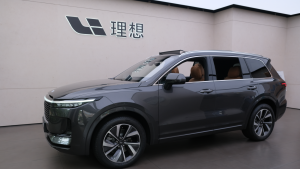The thing is, Chinese EV stocks are among the group that haven’t gotten the same amount of love. It’s not even close. And by most metrics, the Chinese EV market should continue to grow faster, and much larger, than the U.S. market over time.
Here are three Chinese EV stocks that I think fit the profile of many growth investors much better than their U.S. counterparts right now. These are the companies I’m honing in on for the next dip lower in the markets, which appears to be materializing as we speak.
Byd Co. (BYDDF)

BYD (OTCMKTS:BYDDF) remains the top global seller of electric vehicles, with an 18% market share. That’s incredible, and it’s largely due to the fact that BYD focuses on its home market in China. Even more impressive may be the fact that BYD also ranks second in power battery production, expanding its storage capacity surged by over 35% from the previous year.
Recently, BYD’s international sales rose 156% year-over-year to 26,995 vehicles in June 2024. The company sold nearly 1 million new energy vehicles in Q2 2024, up 58% from the previous quarter. In July, BYD posted robust sales, delivering 341,000 vehicles, with a 67% increase in plug-in hybrids but a 4% dip in battery-electric cars. Despite a 31% sales growth year-over-year, BYD’s U.S. stock fell 3.8% due to concerns from the Federal Reserve and the shift in sales mix.
In other BYD news, Uber’s (NYSE:UBER) partnership with Chinese EV maker BYD will add 100,000 electric vehicles to its platform, but only in Europe, Latin America, and other regions €”excluding the U.S. This deal aims to lower EV costs for Uber drivers and boost global adoption.
For those looking for a true mega-cap Chinese EV stock to buy, it’s hard to go wrong with BYD. And notably, this stock has been a pick of Warren Buffett for some time, so it’s got the blessing of the Oracle of Omaha. Can’t say no to that.
Li Auto (LI)

Li Auto’s (NASDAQ:LI) stock is down nearly 50% year-to-date. Like other EV stocks, Li Auto has struggled from a series of sector-specific headwinds that remain strong.
That said, LI stock is increasingly looking undervalued with a forward price-earnings ratio of only 17.8X. Despite a weak industry outlook and EU tariffs, Li Auto’s strong $13.7 billion cash reserve and focus on China, alongside plans for Level 3 self-driving cars by 2025, suggests the potential for a significant rebound.
The stock correction also stemmed from revised growth forecasts and EU tariffs. Nonetheless, Li Auto’s strong $13.7 billion cash reserve and focus on China’s market, with potential Middle East expansion in 2025, highlight growth prospects. The company’s plans to launch Level 3 self-driving technology by 2025 position it well for future gains.
Li Auto faced criticism for sharing weekly sales data of competitors like Aito, Zeekr, and Xiaomi, prompting industry backlash. NIO’s Ma Lin criticized Li Auto’s founder Li Xiang on social media for this “low-level competitive behavior.” The company also reinstated purchase incentives after an eight-day pause, offering up to RMB 10,000 in benefits and exclusive gifts from August 1-13. The promotions, celebrating Chinese Valentine’s Day on August 10, apply to all Li Auto models.
Xpeng (XPEV)

In June, XPeng (NYSE:XPEV) delivered 10,668 vehicles, a 24% increase from last year, driven by the XPENG X9. In H1 2024, deliveries rose 26% to 52,028. Over the next three years, XPeng plans to launch about thirty new and updated models, including the P7+ sedan in Q4 2024 and the Mona M03 hatchback coupe in July.
Recently, Xpeng Aeroht raised $150 million in Series B1 funding and started a Series B2 round, aiming to advance flying car development. It is set to build a factory in Guangzhou for mass-producing flying cars and will start pre-sales in Q4. This funding follows a $500 million Series A round from 2021. Thus, perhaps XPeng is the EV stock turned flying car stock you didn’t know you needed to own. If anything, I view this business as a call option on this high-growth space right now.
Moreover, and perhaps more importantly, Xpeng and Volkswagen (OTCMKTS:VWAGY) recently launched joint-engineering hubs in Guangzhou and Hefei to speed up new EV architecture development. Production for this collaboration is expected to start in two years, with Volkswagen’s China EVs using this advanced architecture from 2026.
Overall, these three EV stocks remain the top considerations for me in my portfolio. If I had to pick among the global players, these are the options I’d consider right now.
On the date of publication, the responsible editor did not have (either directly or indirectly) any positions in the securities mentioned in this article.
On the date of publication, Chris MacDonald did not hold (either directly or indirectly) any positions in the securities mentioned in this article. The opinions expressed in this article are those of the writer, subject to the InvestorPlace.com Publishing Guidelines.
Chris MacDonald’s love for investing led him to pursue an MBA in Finance and take on a number of management roles in corporate finance and venture capital over the past 15 years. His experience as a financial analyst in the past, coupled with his fervor for finding undervalued growth opportunities, contribute to his conservative, long-term investing perspective.
